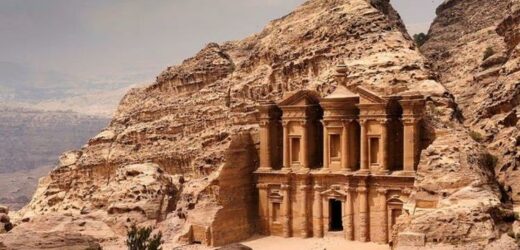Petra: The secret to how the iconic tombs were built is revealed
We use your sign-up to provide content in ways you’ve consented to and to improve our understanding of you. This may include adverts from us and 3rd parties based on our understanding. You can unsubscribe at any time. More info
The city of Petra was once a crucial political, cultural and economic hub. Established as a trading post by the region’s native people — the Nabateans — the city was located in what is now southwestern Jordan. The Nabateans soon accumulated a considerable amount of wealth, leaving the neighbouring Greek Empire envious.
The Greeks attacked the city in 312 BC — the first reference to Petra in recorded history.
But the Nabateans managed to fight back and keep the invaders at bay, using the mountainous terrain surrounding the city which essentially acted as a natural wall to their advantage.
Later, the Romans tried their hand at attacking the city in 106 AD and forced the Nabateans to surrender, annexing the territory and changing its name to Arabia Petraea.
They continued to rule over the city for more than 250 years until the middle of the fourth century AD when an earthquake ripped the city apart.


The Byzantine Empire later took control and governed Petra for some 300 years.
But, by the beginning of the eighth century AD, the city had largely been abandoned and no longer served as a location for commerce, politics or culture — a mystery that has eluded researchers.
While many have claimed the earthquake was enough to do irreparable damage to Petra, others have since claimed that another catastrophe may have hit the city, as explored during the Smithsonian Channel’s documentary, ‘Secrets: Riddle of Petra’.
Here, Dr Tom Paradise revealed evidence that he believed proved Petra was “the victim of another form of catastrophe”.
JUST IN: Roman Empire exposed as ‘cruelty’ of general Scipio ‘became hallmark’

Along Petra’s collonaded main street, a team of archaeologists investigating a line of shops in 2017 came across something puzzling.
As Dr Paradise explained: “What they uncovered was massive beds of very white sandstone.”
Holding a piece of the brick red sand that’s native to the area of Petra, he noted: “It’s much more characteristic of the lower part of the valley,” before picking up a piece of white sand: “This characteristic white sand doesn’t belong here.”
The team had found white sand in a valley exclusively of red rock.
DON’T MISS
Russia sends terrifying threat as millions of Britons face winter cris [REPORT]
Mystery illness outbreak: Six dead as investigation launched [INSIGHT]
Mysterious 200-year-old shipwreck could be Royal Navy warship [ANALYSIS]


On inspecting the surrounding area, Dr Paradise, soon realised that the white sand resembled the sandstone across the valley at the top of a hill.
He said: “This started a longer inquiry that would lead us to conclude that Petra may have literally been hit by a massive, massive flood.”
During the rainy season, Petra was known to fall victim to severe flooding.
Only in 1963 had floods at Petra’s main entrance, the Siq, killed 22 visitors after waters pounded down on the valleys below.

Archaeological analysis of the layout of the city has suggested that the Nabateans were all too aware of the risk of flooding even 2,000 years ago.
They knew it was essential to keep the Siq dry, as it was their main connection to the outside world, and so created a tunnel to redirect any potential excess rainfall.
At the tunnel’s entrance, however, Dr Paradise spotted “clear evidence” that at some point, water was massively backed up, leaving open the possibility of a spillover.
He said: “We’re looking at five, six, seven metres of floodwater at this point — that would have been an extraordinary amount of water.”

If right, the water would have poured over the hill’s edge, backing up into the city and covered the streets with up to 16 feet of sand and debris.
After Petra was abandoned in the eighth century, its stone structures were used for shelter by nomadic shepherds for several centuries.
Then, in 1812, Swiss explorer Johann Ludwig Burckhardt came across the ruins during one of his trips, describing them in a chronicle of his journey.
With the Western world now aware of the existence of a lost city, scholars, explorers, academics and archaeologists travelled to Petra to see for themselves.
A formal project to excavate and survey Petra was soon launched.
In 1985, the site was named a UNESCO World Heritage Site, and by the early Noughties, it became one of the “Seven New Wonders of the World”.
Source: Read Full Article


